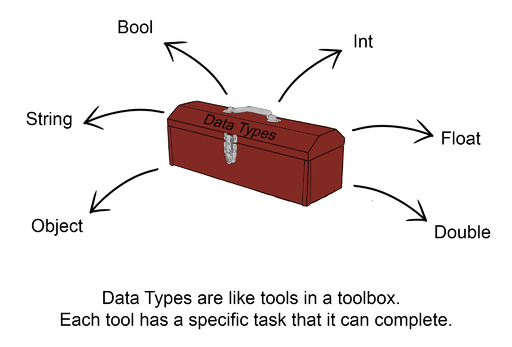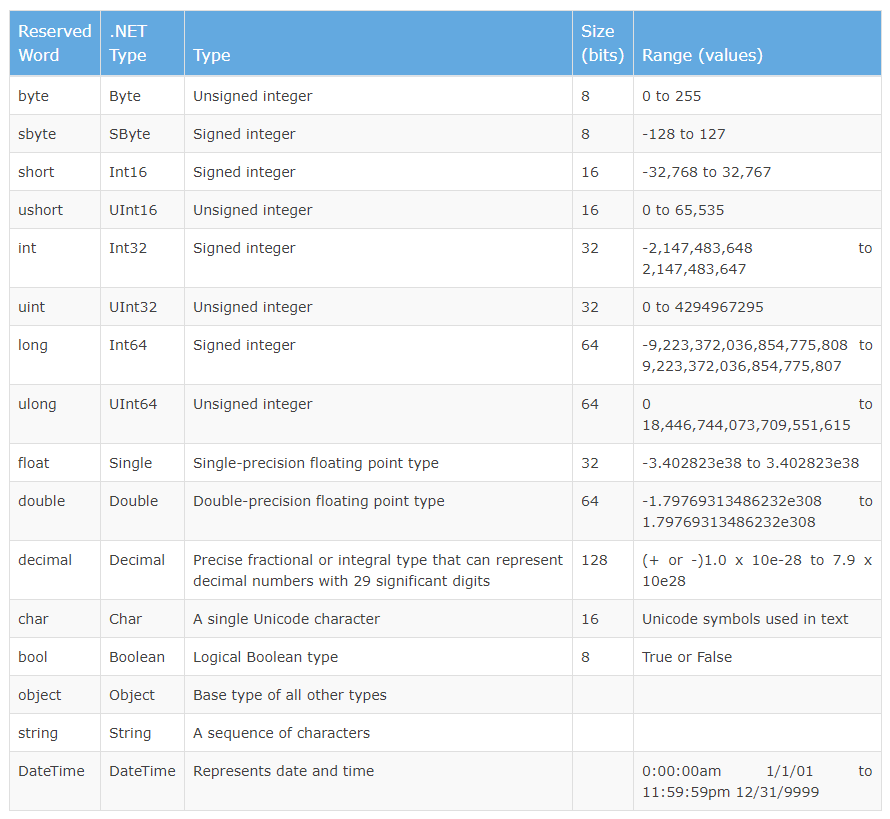Difference between revisions of "Data Type"
(→Explanation) |
|||
| (8 intermediate revisions by 3 users not shown) | |||
| Line 4: | Line 4: | ||
=Relevance= | =Relevance= | ||
*[[Boolean]] | *[[Boolean]] | ||
| − | |||
*[[Character]] | *[[Character]] | ||
| + | *[[Integer]] | ||
| + | *[[Floating Point Number]] | ||
| + | *[[Double]] | ||
*[[Decimal]] | *[[Decimal]] | ||
| − | |||
| − | |||
| − | |||
| − | |||
| − | |||
| − | |||
*[[String]] | *[[String]] | ||
| − | |||
=Explanation= | =Explanation= | ||
| + | There are many different types of data types that are used for different tasks. Similar to a Mechanic using the right tool for the job, it is the job of the programmer to figure out which data type would be appropriate to use. | ||
| + | |||
| + | [[File:DataTypesVisual.png|512px]] | ||
| + | |||
| + | |||
Information falls under a different data type. Different data types are used for different intents: for math you may use integers, floats, doubles, etc. while for keeping a contact list, strings would be more appropriate. | Information falls under a different data type. Different data types are used for different intents: for math you may use integers, floats, doubles, etc. while for keeping a contact list, strings would be more appropriate. | ||
As mentioned before, data types limit which operations can be used on them. A string cannot be added to an integer because an integer can only be a whole number while a string can be a name, address, etc. However, an integer can be added to a string, this is known as [[Concatenation]]. It’s all about using the right data type for the right job. | As mentioned before, data types limit which operations can be used on them. A string cannot be added to an integer because an integer can only be a whole number while a string can be a name, address, etc. However, an integer can be added to a string, this is known as [[Concatenation]]. It’s all about using the right data type for the right job. | ||
| Line 23: | Line 23: | ||
[[File:Data types.PNG]] | [[File:Data types.PNG]] | ||
| + | |||
| + | Credits: https://www.tutorialsteacher.com/csharp/csharp-data-types | ||
=Example= | =Example= | ||
Here's an example of a few different types of variables being initialized along with a few [[Comment]]s | Here's an example of a few different types of variables being initialized along with a few [[Comment]]s | ||
| − | |||
| − | |||
| − | |||
| − | |||
| − | |||
| − | |||
| − | |||
| − | |||
| − | |||
| − | |||
| − | |||
| − | |||
| − | |||
| − | |||
| − | |||
| − | |||
| − | |||
| − | |||
| − | |||
| − | |||
| − | = | + | <syntaxhighlight lang ="csharp"> |
| + | string fullName = "John Doe"; // strings are typically used to store information such as names, addresses, etc. because they can hold text. | ||
| + | string jobTitle = "Sales Associate"; // notice how a string's value has the quotation marks! | ||
| + | bool isStudent= true; // booleans can only be true or false. Great use in conditional statements! | ||
| + | int age = 20; // an int (short for integer) can only be a whole number. Since we typically say age as a whole number, we're using an int | ||
| + | float payrate= 12.50f; // unlike integers, a float (short for floating-point number) can hold more complex numbers with decimal places. Great for displaying the example's payrate! | ||
| + | </syntaxhighlight> | ||
| + | |||
== See also == | == See also == | ||
* [[C Sharp Data Types]] | * [[C Sharp Data Types]] | ||
| Line 53: | Line 42: | ||
* [[.NET Data Types]] | * [[.NET Data Types]] | ||
| − | + | *[[Boolean]] | |
| + | *[[Byte]] | ||
| + | *[[Character]] | ||
| + | *[[Decimal]] | ||
| + | *[[Double]] | ||
| + | *[[Dynamic]] | ||
| + | *[[Floating Point Number]] | ||
| + | *[[Integer]] | ||
| + | *[[Long]] | ||
| + | *[[Short]] | ||
| + | *[[String]] | ||
| + | *[[Var]] | ||
| + | |||
| − | |||
Latest revision as of 16:22, 8 August 2019
Contents
Definition
A data type is an attribute of data that tells the compiler how the programmer intends on using the data. A data type limits the values that an expression might take.
Relevance
Explanation
There are many different types of data types that are used for different tasks. Similar to a Mechanic using the right tool for the job, it is the job of the programmer to figure out which data type would be appropriate to use.
Information falls under a different data type. Different data types are used for different intents: for math you may use integers, floats, doubles, etc. while for keeping a contact list, strings would be more appropriate.
As mentioned before, data types limit which operations can be used on them. A string cannot be added to an integer because an integer can only be a whole number while a string can be a name, address, etc. However, an integer can be added to a string, this is known as Concatenation. It’s all about using the right data type for the right job.
Here is a list of different data types available in C#
Credits: https://www.tutorialsteacher.com/csharp/csharp-data-types
Example
Here's an example of a few different types of variables being initialized along with a few Comments
string fullName = "John Doe"; // strings are typically used to store information such as names, addresses, etc. because they can hold text.
string jobTitle = "Sales Associate"; // notice how a string's value has the quotation marks!
bool isStudent= true; // booleans can only be true or false. Great use in conditional statements!
int age = 20; // an int (short for integer) can only be a whole number. Since we typically say age as a whole number, we're using an int
float payrate= 12.50f; // unlike integers, a float (short for floating-point number) can hold more complex numbers with decimal places. Great for displaying the example's payrate!

